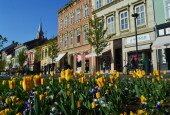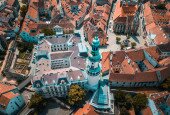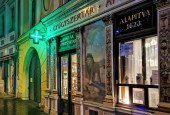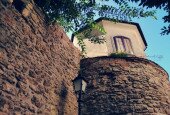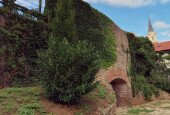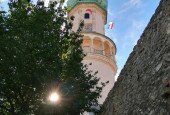The Castle Wall Promenade and the Castle District
The Sopron castle wall and town wall is unique in Hungary, because it has been here since Roman times, for 1600 years, defining the image of the historical downtown (Castle District) and the outer side of the castle wall, the Castle District.
The castle wall is completely incorporated into the town, so we cannot enjoy the panorama from the wall because of the buildings that are in front of it. But walking on the Castle Wall Promenade formed in the former moat, we can travel back in time all the way to Roman times, just like on a historical educational trail. You can learn from the information boards that the trail of the town wall and the semi-circular bastion forts were left to us from Roman times. After the fall of the Roman Empire, the town was abandoned, but the ruins of the Roman town walls are still with us. They became the base of the castle rampart in the times of Árpád (the so-called “red rampart”), the 11th century. At the end of the 13th century and in the first half of the 14th century, the triple town wall, and the north gate tower as well as the lower, cylindrical part of today's Fire Tower were built. In the first half of the 17th century, several bastion forts were added to the medieval town wall, of which only the Great (St. George) bastion fort remained. After the Turkish threat was gone, the castle wall lost its military significance and the moat was filled up. On the land plots created on the former site of the moats, the rich ones built residential palaces, the less wealthy ones built narrow residential buildings, shaping the diverse inner row of houses in the Castle District. The buildings of the outer row of houses are older, many of them of medieval origin. Several of such buildings can be found in the section of the Castle District between Ikvahíd Street and Ógabona Square, in the so-called Little Castle District. The most characteristic of them is the Rejpál House and the neighbouring Festőköz (Painters' Passage), through which the blue-dye painters carried their canvases to the attic of the nearby painting house. Not far from the charming medieval passage you can see the façade of the Lion's Pharmacy ornamented with Zsolnay majolica. The pharmacy has been operating here for almost 300 years, but its legal predecessor, the Golden Eagle Pharmacy, was operating in the adjacent building since 1623. In the section from Ikvahíd Street to Széchenyi Square, inns used to line up to host many famous people. Just a few names without claiming completeness: Miklós Zrínyi, poet and warlord, Joseph Haydn, Ferenc Liszt, Johann Strauss Jr., Joseph II as heir to the throne ("King with a Hat") and Ferenc Joseph as King of Hungary. On the north-western edge of the former castle wall you will find the medieval Ógabona Square, and in the south-western and southern parts, after filling up the lakes that used to supply the moat with water, today's Petőfi Square and Széchenyi Square were built. It is worth taking a walk around the former town wall, where visitors can have countless experiences. Visit and enjoy the Castle Wall Promenade with its Mediterranean feel, the shops and cafés lined up in the ancient houses of the Castle District, the music fountain of Petőfi Square with the Petőfi Theatre, and the benches of Széchenyi Square from where you can see the statue of the eponymous István Széchenyi and the only two-towered church in the town, the Dominican Church.


